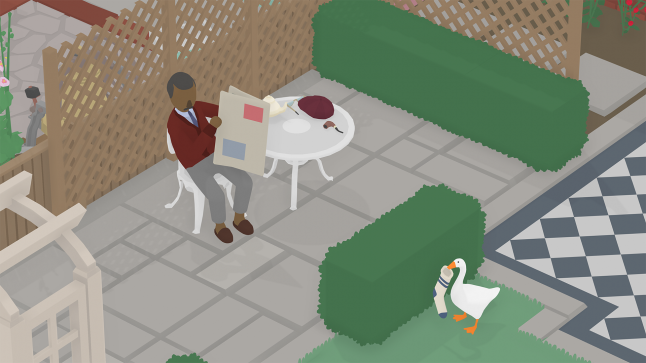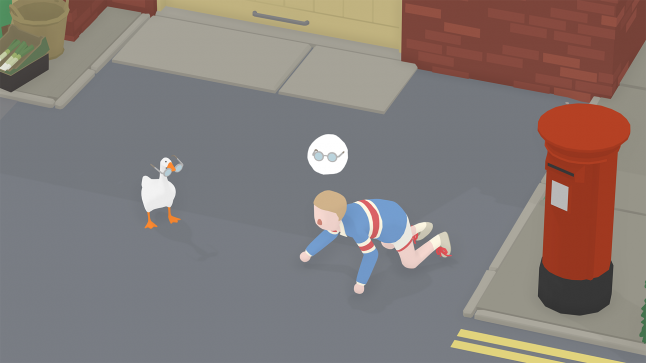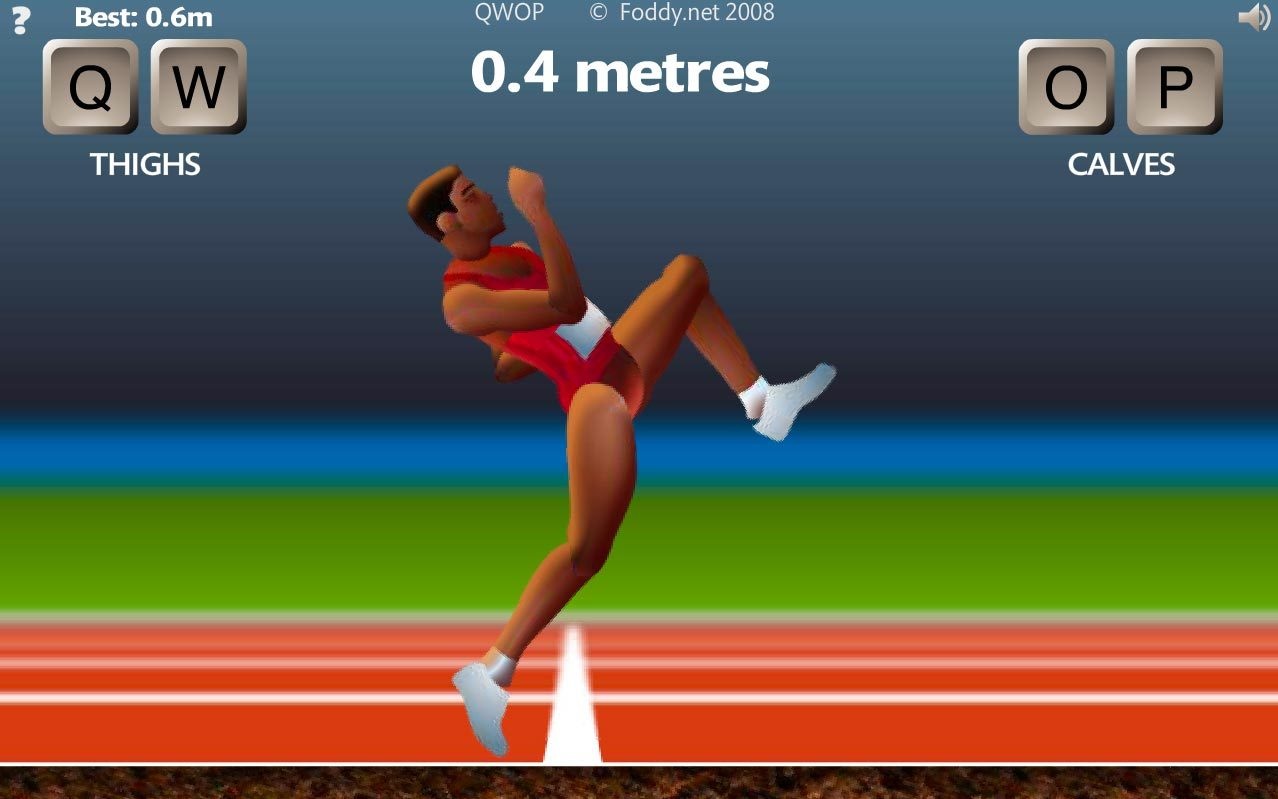Interview with one of the creators of Untitled Goose Game

It seems that today everyone began to quack a little more than usual, because recently an amazing game House House Studios Untitled Goose Game was released , in which the player controls a harmful goose that terrorizes unsuspecting residents of a small town.
Game House programmer Nico Disseldorp from House House recently answered all our questions about geese.
Gamasutra: who are you, what is House House, and what is an Untitled Goose Game ?
Nico Disseldorp: House House consists of four people - Nico Disseldorp (me), Michael MacMaster, Jake Strasser and Stuart Gillespie Cook. Although each of us has our own specialization in everyday life (I, for example, a programmer), the more important part of our work is that we discuss everything together. Everything is decided by consensus, so all four choose what the game will be.
We were all friends even before we started making video games, and took up our first game Push Me Pull You , because we thought it was a great way to spend time together. The game attracted the attention of several people, everything grew very slowly, and in the end we turned into a gaming company.
In the goose game, you control a nasty goose that tries to ruin everyone’s life. The idea of the game originated from this premise, and gradually we came up with what fun things a goose can do, how funny people can react, until finally a game begins to form around this idea.
Not only the four of us worked on the Untitled Goose Game . We were assisted by sound designer Em Halberstadt, Kalonika Quigley, who created additional graphics and animations, Dan Golding, who wrote music, and Cherie Davison, who programmed the customizable controls.

Gamasutra: Untitled Goose Game first appeared on the scene two years ago, in an unforgettable video from YouTube , spread across many sites. How useful were social networks in promoting and advertising the game?
Disseldorp: This video was recorded by one of the developers, Jake. He had experience in film and television, so work on the trailer turned out to be quite natural for him. The video itself was made quite quickly, because we assumed that not many people would see it. Now I believe that the lack of “over-thought” helped this video.
After publishing this video online, it turned out to be quite popular, and something strange happened to it: sites reposted it as part of a “funny video” rather than as a “game trailer”. Perhaps this contributed to the fact that the game did not have a name? The great success of the video came as a surprise to us and definitely influenced our perception of the game being developed.
In general, we adhere to such a strategy regarding social media: think as little as possible about social media. We wanted to focus on making the game. But we knew that Jake could make good videos, so we usually ignored social media until we could say something important, for example, a statement about the platform or release date, and a video was already made for this event.
Although it often seemed to me that I should write more tweets, I think this strategy worked quite well. One person told me that he likes the “mystery” of our behavior in social networks, which is very generous of him. I would rather say that this is simply "negligence."
Gamasutra: the tone of the game is curious. Nobody speaks in it, but the behavior and gestures of the characters tell a lot about them. What was your inspiration for creating this style? Were you worried that you would get an ordinary humorous game? Have you been tempted to make it bigger?
Disseldorp: the whole idea of the game originated from the realization that a person’s collision with a frightening goose is just such a common and mundane conflict. When a goose is chasing a person, this is absurd, but this constantly happens to people. Therefore, such a routine, daily routine of the situation was very important.
In the process of development, we constantly had the idea to do something more, for example, to goose ruined someone else’s wedding, but we did not give such ideas for development, because we wanted to feel that this is a completely ordinary day in the life of the characters. Everything that arose was extraordinary, was the result of the goose.
I think this lack of escalation of events also helped in creating the structure of the game that we wanted. Human characters are able to fix most of the problems and return things to their place, giving the goose a chance to do the same pranks again and again. His ugliness is quite cyclical.

Gamasutra: each character has important things for him and his own reactions to their disappearance. How did you create and polish such emergent gameplay? How many iterations did you do, and how did it change during the development process? And when you realized that the game is really funny, how did you isolate and perfect humor?
Disseldorp: we didn’t have any special preliminary plan on how everything should work. In this sense, the process was very iterative. We started with the premise “you are a harmful goose” and vague ideas such as “a goose can steal things from people,” which seemed funny. And then we went in the opposite direction and began to add systems that implement the points we need.
We created one AI character (the gardener's predecessor from the game) and simply gradually added new behaviors that seemed appropriate to the situations we needed. First of all, we gave him several items that a goose could steal, and made the character chase the goose in order to return them. At this stage, we did not have any understanding of how the gameplay would develop, whether the goose would have any goals, we simply tried to add things so that the theft of things was more interesting.
Gradually, this led us to create cycles of passive actions in which people use their objects, adding reaction animations for transitions between states. We also added visibility cones, memorable positions, “bubbles” with thoughts. Now we can say that we learned many of these aspects from stealth games, but we took them one at a time in order to achieve exactly those small-scale interactions that we need.
Gamasutra: they haven’t talked much about it yet, but those who noticed paid attention to it: the interactive musical accompaniment is simply magnificent . This is probably the best procedural soundtrack I have heard ... How the soundtrack adapts to the current situation; how he postpones musical parts, choosing the perfect time for the right notes; how he sometimes seems triumphant when a goose manages to perform one of the robberies; how the themes of different characters begin to play when changing areas, and so on. What else can he do, and how did you manage to achieve all this? Do you plan to sell a soundtrack?
Disseldorp: the history of the game’s music began with the fact that in the early stages of development we liked how it felt under the old piano solos from Debussy’s preludes. They reminded us of silent films or old musical cartoons, but they were much milder. Conveniently, these compositions were already in the public domain, and we could use them.
We decided to take Debussy as the music for the trailers, and we asked Dan Golding (who wrote the music for Push Me Pull You too ) if he could make a new record for the trailer. This trailer turned out to be very popular, and commentators often mentioned how they liked the music that responded to the gameplay. It was a mistake, the music did not respond to the game (but we cut the trailer to the music, and not vice versa). However, this particular track jumped between unrelated musical phrases, which is why people actually thought that the game had “reacting” music.

Optimistically (and perhaps naively) we thought that we need to create just such a system that the audience mistakenly discovered: to reproduce different parts of the Debussy composition with unrelated fragments so that the game responds to what the player is doing. We decided that if everything was done correctly, we would have the feeling that a live pianist was accompanying the game process.
It took us several attempts to find a working solution, but as a result we got a system that we are very pleased with. The finished system contains two versions of each track; one sounds like the original composition, and the other is a “low energy” version that plays more muffledly. Dan divided each version into hundreds of different audio files, each of which represented two measures of music. Depending on the action on the screen, the game can switch between playing high and low energy versions without noticeable joints, pause or mute the melody.
Currently, there are only two possible audio files that can be played next, but since the game has so many possibilities to switch to high or low energy or muffle music, it is very easy for it to create perfectly matched time transitions between energies that seem intentional and accurate.
We will release the soundtrack (hopefully soon), but we still need to figure out how it will work. Obviously, in a game, music plays differently each time, and the soundtrack will always be the same. I think Dan has thoughts on how to implement this, and I will be happy to appreciate the results.
Gamasutra: after examining the old trailer of 2017, you can notice minor differences. For example, that in the finished game a little more non-soundtrack music. Quiet “top-top” goose appeared, and his voice became much more realistic (before he was just rude quack). I also noticed that the radios in the game have several radio stations. How important was it for you to correctly implement the sound, and what part of the effort to create the game was spent on this?
Disseldorp: the old trailer used standard sounds taken from free online collections.
In 2018, Em Halberstadt came to us and replaced them with the sounds that you hear today. She was extremely meticulous and worked hard to find unique sounds in different places. Here is one example: the game has about 160 unique objects, and all of them have unique sounds of raising, throwing, hitting concrete, falling onto grass, dragging and dropping on different surfaces. It seems incredible to me. The result is a very exciting system - when you just touch everything in the game, this in itself seems like a game, you are interested to know what sounds each object can make.
Gamasutra: after completing the main game, players continue to return to it to study unexpected interactions between different objects. Although it’s a little sad that we can’t get the old man to put on the gardener's hat (yes, I tried to do it), I was pleased to know that if you hide in a box in the courtyard of the “neat neighbor”, the goose will be thrown behind the fence! Many of these aspects are emphasized by the list items at the end of the game.
Did you plan such things initially, or did some interactions arise from the properties of objects? Did any interactions surprise you? Would you like to pay attention to any special interactions?
Disseldorp: such things were a combination of systemic gameplay that worked after we set everything up correctly and manually created interactions - we tried to predict what else people might try to do or assume that it would work. We are very pleased that the border between these two approaches turned out to be very blurred - it is not always obvious to the player what is “basic behavior” and what is spelled out manually.
It was important for us to take into account borderline cases, which, according to people, “should” work out so that they believe in the possibility of their experiments. Our game is for people who believe that their stupid ideas can work, so if we had the rule “you can pull off slippers while the owner’s feet are not on the ground”, then we had to look for other situations in which slippers are not on the ground, so that they could also be stolen.
It seems that we did not add too many items specifically for the task lists that appear after the final credits. We just tried to come up with interesting things that the player could already do in the game, and wrote them down.
Now that people play the game at home, some things really surprise us. Over the past week, we watched several videos and streams, and even surprised us a lot , for example, when a player broke a mop, dragging it with another character, and the like.
At the same time, we understood that we would not be able to take into account any possibility, some things might not work for the players for technical reasons or because we did not have time to implement them. Therefore, we needed to signal to the players that some things would not work. For example, one of the first objects in the game is a bright red lawn mower that looks like it can be turned on. We didn’t manage to add interactions for her, but left her at the level, because we found that this was a good way to calibrate the players ’expectations. In this game, many things work, and some do not, and this is normal.

Gamasutra: it seems to me that for the most part the charm and amusement of the Untitled Goose Game is due to the slowness of the goose itself ... But the goose is well managed; This is the perfect combination of clumsiness and dexterity; despite how flexible and adaptive his model looks, it always looks and feels not like a model, but like a real, realistic goose, and because of this, some tasks, such as “Score a Goal,” become much more complicated. How did you simulate the goose's appearance and management?
Disseldorp: goose control requires a bit more active attention to low-level aspects, such as pulling and moving, than in many other similar games. It seems to me that such complication helps to reduce the scale of interactions. Some things, so trivial that they are not even mentioned in other games, for example, “come here and take an item”, are made in our game a little more physical and interesting. There are enough of them in order to understand whether the developer did the job well.
Extreme focus on such small-scale movements are games like QWOP , where it is almost impossible to move, and just walking becomes a huge achievement. I think we wanted to add the same ingredient to the goose, but only in a very small dose. This is like 1 percent of QWOP .

Speaking in a more general sense, the question here is to avoid mastery. In many games, it is assumed that the movement is trivial, and the complexity of the game is connected with something genre, for example, shooting or jumping. But such things lead to the fact that most of the time the character seems very natural, and then kills hundreds of people or jumps on stacks of boxes. One way to avoid this is to create a game that does not have these kinds of difficulties, for example, a walk simulator, and we also tried to create complexity in other aspects . In our game, a little more complicated movement, less obvious clues, and the like.
All Articles